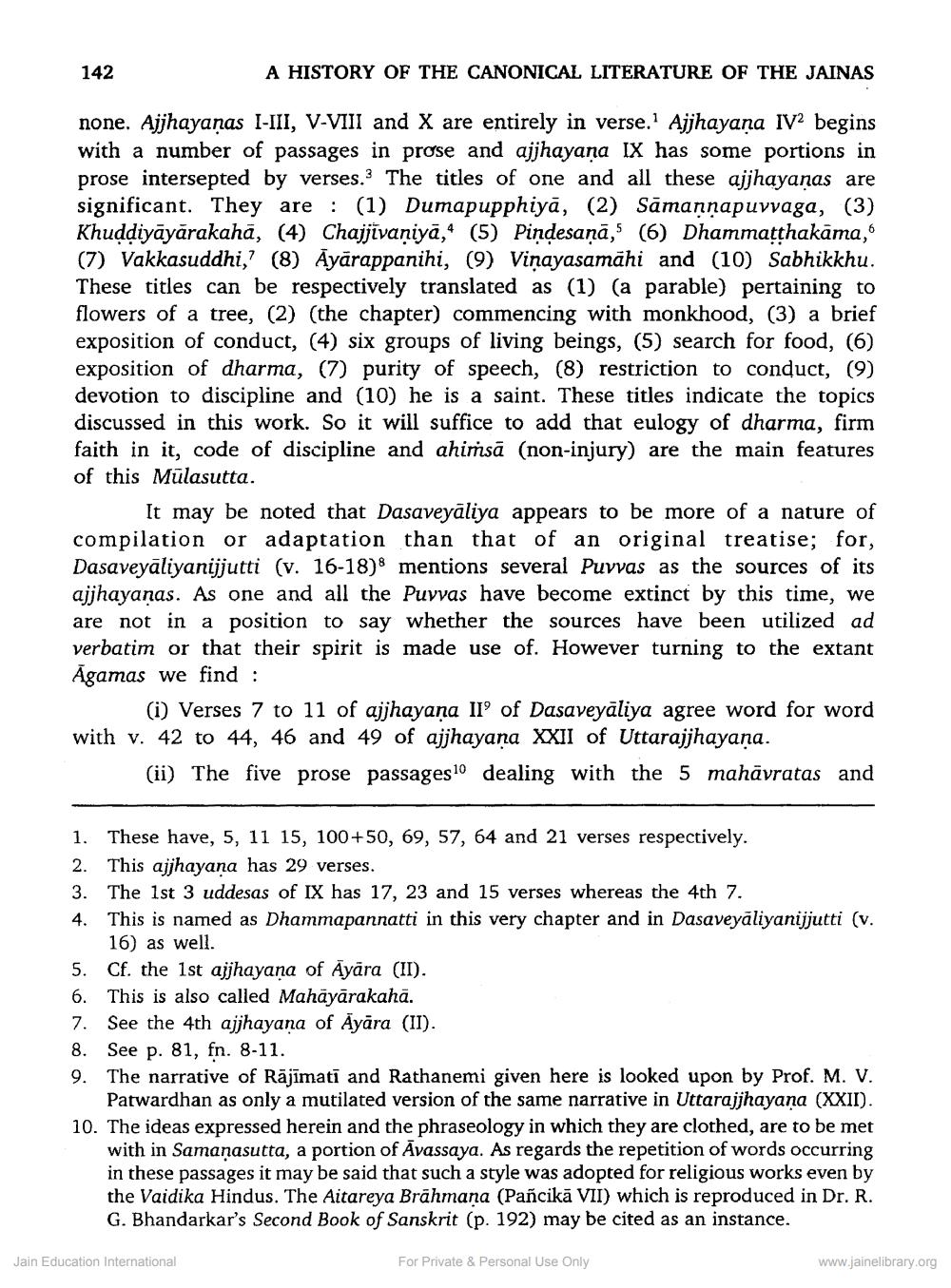________________
142
A HISTORY OF THE CANONICAL LITERATURE OF THE JAINAS
none. Ajjhayanas I-III, V-VIII and X are entirely in verse.' Ajjhayana IV2 begins with a number of passages in prose and ajjhayana IX has some portions in prose intersepted by verses. The titles of one and all these ajjhayanas are significant. They are: (1) Dumapupphiyā, (2) Samannapuvvaga, (3) Khuddiyāyārakahā, (4) Chajjivaniyā,4 (5) Pindesaņā, (6) Dhammatthakama, (7) Vakkasuddhi,? (8) Āyārappanihi, (9) Vinayasamāhi and (10) Sabhikkhu. These titles can be respectively translated as (1) (a parable) pertaining to flowers of a tree, (2) (the chapter) commencing with monkhood, (3) a brief exposition of conduct, (4) six groups of living beings, (5) search for food, (6) exposition of dharma, (7) purity of speech, (8) restriction to conduct, (9) devotion to discipline and (10) he is a saint. These titles indicate the topics discussed in this work. So it will suffice to add that eulogy of dharma, firm faith in it, code of discipline and ahiṁsā (non-injury) are the main features of this Mülasutta.
It may be noted that Dasaveyaliya appears to be more of a nature of compilation or adaptation than that of an original treatise; for, Dasaveyaliyanijjutti (v. 16-18) mentions several Puvvas as the sources of its ajjhayanas. As one and all the Puvvas have become extinct by this time, we are not in a position to say whether the sources have been utilized ad verbatim or that their spirit is made use of. However turning to the extant Agamas we find :
(i) Verses 7 to 11 of ajjhayana II of Dasaveyaliya agree word for word with v. 42 to 44, 46 and 49 of ajjhayana XXII of Uttarajjhayana.
(ii) The five prose passages 10 dealing with the 5 mahāvratas and
1. These have, 5, 11 15, 100+50, 69, 57, 64 and 21 verses respectively. 2. This ajjhayana has 29 verses. 3. The 1st 3 uddesas of IX has 17, 23 and 15 verses whereas the 4th 7. 4. This is named as Dhammapannatti in this very chapter and in Dasaveyaliyanijjutti (v.
16) as well. 5. Cf. the 1st ajjhayana of Ayāra (II). 6. This is also called Mahāyārakahā. 7. See the 4th ajjhayana of Āyāra (II). 8. See p. 81, fn. 8-11. 9. The narrative of Rājīmati and Rathanemi given here is looked upon by Prof. M. V.
Patwardhan as only a mutilated version of the same narrative in Uttarajjhayana (XXII). 10. The ideas expressed herein and the phraseology in which they are clothed, are to be met
with in Samaņasutta, a portion of Avassaya. As regards the repetition of words occurring in these passages it may be said that such a style was adopted for religious works even by the Vaidika Hindus. The Aitareya Brahmana (Pañcikā VII) which is reproduced in Dr. R. G. Bhandarkar's Second Book of Sanskrit (p. 192) may be cited as an instance.
Jain Education International
For Private & Personal Use Only
www.jainelibrary.org




